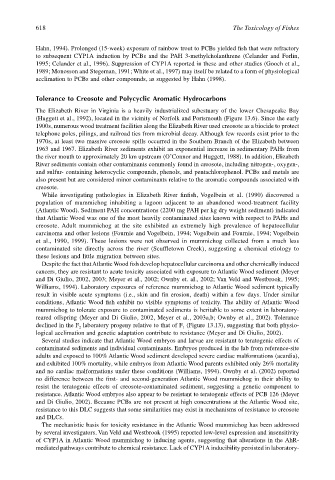Page 638 - The Toxicology of Fishes
P. 638
618 The Toxicology of Fishes
Hahn, 1994). Prolonged (15-week) exposure of rainbow trout to PCBs yielded fish that were refractory
to subsequent CYP1A induction by PCBs and the PAH 3-methylcholanthrene (Celander and Forlin,
1995; Celander et al., 1996). Suppression of CYP1A reported in these and other studies (Gooch et al.,
1989; Monosson and Stegeman, 1991; White et al., 1997) may itself be related to a form of physiological
acclimation to PCBs and other compounds, as suggested by Hahn (1998).
Tolerance to Creosote and Polycyclic Aromatic Hydrocarbons
The Elizabeth River in Virginia is a heavily industrialized subestuary of the lower Chesapeake Bay
(Huggett et al., 1992), located in the vicinity of Norfolk and Portsmouth (Figure 13.6). Since the early
1900s, numerous wood treatment facilities along the Elizabeth River used creosote as a biocide to protect
telephone poles, pilings, and railroad ties from microbial decay. Although few records exist prior to the
1970s, at least two massive creosote spills occurred in the Southern Branch of the Elizabeth between
1963 and 1967. Elizabeth River sediments exhibit an exponential increase in sedimentary PAHs from
the river mouth to approximately 20 km upstream (O’Connor and Huggett, 1988). In addition, Elizabeth
River sediments contain other contaminants commonly found in creosote, including nitrogen-, oxygen-,
and sulfur- containing heterocyclic compounds, phenols, and pentachlorophenol. PCBs and metals are
also present but are considered minor contaminants relative to the aromatic compounds associated with
creosote.
While investigating pathologies in Elizabeth River finfish, Vogelbein et al. (1990) discovered a
population of mummichog inhabiting a lagoon adjacent to an abandoned wood-treatment facility
(Atlantic Wood). Sediment PAH concentrations (2200 mg PAH per kg dry weight sediment) indicated
that Atlantic Wood was one of the most heavily contaminated sites known with respect to PAHs and
creosote. Adult mummichog at the site exhibited an extremely high prevalence of hepatocellular
carcinoma and other lesions (Fournie and Vogelbein, 1994; Vogelbein and Fournie, 1994; Vogelbein
et al., 1990, 1999). These lesions were not observed in mummichog collected from a much less
contaminated site directly across the river (Scuffletown Creek), suggesting a chemical etiology to
these lesions and little migration between sites.
Despite the fact that Atlantic Wood fish develop hepatocellular carcinoma and other chemically induced
cancers, they are resistant to acute toxicity associated with exposure to Atlantic Wood sediment (Meyer
and Di Giulio, 2002, 2003; Meyer et al., 2002; Ownby et. al., 2002; Van Veld and Westbrook, 1995;
Williams, 1994). Laboratory exposures of reference mummichog to Atlantic Wood sediment typically
result in visible acute symptoms (i.e., skin and fin erosion, death) within a few days. Under similar
conditions, Atlantic Wood fish exhibit no visible symptoms of toxicity. The ability of Atlantic Wood
mummichog to tolerate exposure to contaminated sediments is heritable to some extent in laboratory-
reared offspring (Meyer and Di Giulio, 2002, Meyer et al., 2003a,b; Ownby et al., 2002). Tolerance
declined in the F laboratory progeny relative to that of F (Figure 13.13), suggesting that both physio-
1
2
logical acclimation and genetic adaptation contribute to resistance (Meyer and Di Giulio, 2002).
Several studies indicate that Atlantic Wood embryos and larvae are resistant to teratogenic effects of
contaminated sediments and individual contaminants. Embryos produced in the lab from reference-site
adults and exposed to 100% Atlantic Wood sediment developed severe cardiac malformations (acardia),
and exhibited 100% mortality, while embryos from Atlantic Wood parents exhibited only 26% mortality
and no cardiac malformations under these conditions (Williams, 1994). Ownby et al. (2002) reported
no difference between the first- and second-generation Atlantic Wood mummichog in their ability to
resist the teratogenic effects of creosote-contaminated sediment, suggesting a genetic component to
resistance. Atlantic Wood embryos also appear to be resistant to teratogenic effects of PCB 126 (Meyer
and Di Giulio, 2002). Because PCBs are not present at high concentrations at the Atlantic Wood site,
resistance to this DLC suggests that some similarities may exist in mechanisms of resistance to creosote
and DLCs.
The mechanistic basis for toxicity resistance in the Atlantic Wood mummichog has been addressed
by several investigators. Van Veld and Westbrook (1995) reported low-level expression and insensitivity
of CYP1A in Atlantic Wood mummichog to inducing agents, suggesting that alterations in the AhR-
mediated pathways contribute to chemical resistance. Lack of CYP1A inducibility persisted in laboratory-

